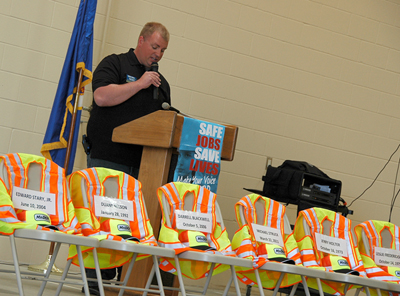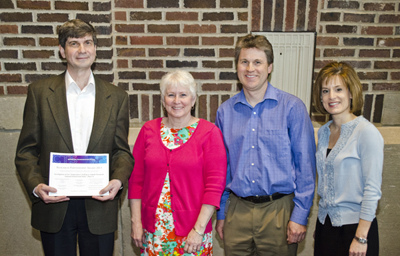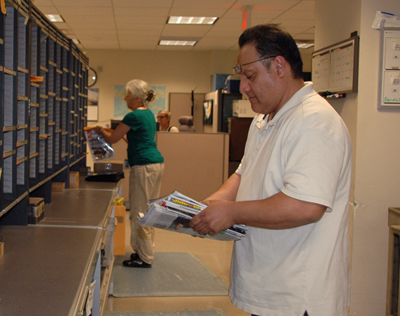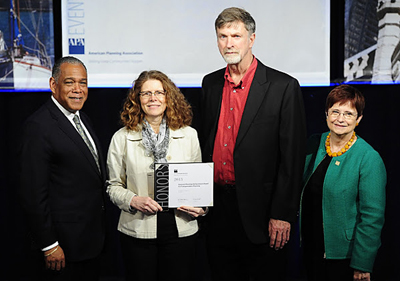 |
|

|
 |
TABLE of CONTENTS
 |
Workers Memorial Day events held around Minnesota |
By Rich Kemp

Chris Hanson, District 7 maintenance and AFSCME Local 280 president, spoke at the Workers Memorial Day event in Mankato April 29. Thirty-three chairs, each representing a MnDOT employee killed on the job, lined the area in front of the lectern. Photo by Rich Kemp |
Several events around Minnesota on Monday, April 29, marked Workers Memorial Day, which honors the fallen workers who have died while working on MnDOT construction and maintenance projects.
“The passing of these workers is a tragic reminder of the dangers men and women face while keeping Minnesota’s roads safe for the driving public,” said Commissioner Charlie Zelle. “It is important that we honor all workers who lost their lives on-the-job by using extra caution in work zones."
Since 1960, 33 MnDOT employees and 16 private sector contractors have lost their lives on the job while working on Minnesota highways.
The event in Rochester started at 8:30 a.m. at the District 6 maintenance facility. Chuck Ackman, representing Sen. Amy Klobuchar, read a letter from Klobuchar, and Bruce Barnum, representing Sen. Al Franken, read a letter from Franken. Other speakers included Jeff Vlaminck, District 6/Rochester engineer; Laura Askelin, Southeast Minnesota Area Labor Council; Rochester Mayor Ardell Brede and Lt. Heath Dienger, Minnesota State Patrol. There were six chairs set up with a vest, hat and poster to represent the six District 6 employees who have lost their lives on-the-job.
At 9 a.m., an event to honor the fallen workers was held at the MnDOT Waters Edge building in Roseville. Commissioner Zelle was one of the speakers, along with Metro District Engineer Scott McBride, Minnesota State Patrol Sergeant Paul Skoglund, Tim Worke, Association of General Contractors, and Mike Lindholt, AFSCME Local 221 president. Family members of fallen MnDOT employee Ed Stary, Jr., and contract employees Ronald Rajkowski and Craig Carlson, were at the event to honor their loved ones.
The Metro District also recognized individuals who have gone above and beyond to ensure work zone safety. Honored for their efforts were Brian Barott, Wayne Tennison, Ryan Fredrickson, Lenny Traxler, Kevin Farraher, Dale Dombroske, Jeff Streeter, Greg Kincade, Dewayne Jones, Doug Thies and Ron Weiderhoft.
|
Metro District observes Workers Memorial Day April 29 at Waters Edge Building in Roseville. Video by Joel Wenz and Clay Ebeling, Video Services |
The District 7 Mankato event kicked off with a lunch at 11:45 a.m. at the headquarters maintenance facility. Speakers for the event were Chris Hanson, District 7 maintenance and AFSCME Local 280 president; Stacy Karels, Mankato Building Trades; Keith Juliar, District 7 safety administrator; and Lt. Jeremy Geiger, Minnesota State Patrol. The families of Mike Struck and Darrell Blackwell, District 7 employees who lost their lives while working for MnDOT, were in attendance.
“A lot of people in this room have been adversely affected by workplace accidents,” said Hanson. “We are all here today to remember those who were lost and to raise awareness about safety and preventing workplace injuries and deaths.”
At the Metro and District 7 events, 33 chairs with a vest, hat and gloves were setup to honor the MnDOT employees who lost their lives. At the Central Office there was a chair with a vest, hat, gloves and poster stationed on each floor by the elevators. Each event included 10 seconds of silence to honor the workers and their families.
In recognition of Workers Memorial Day, the Interstate 35W Bridge in Minneapolis was lit orange on Monday, April 29, from 12:01 a.m. to midnight.
For more information on Worker Memorial Day and to listen to the commissioner’s message, see:
/www.dot.state.mn.us/const/tools/workermemorial.html
|
 |
|

|
|

|
 |
TABLE of CONTENTS
 |
Program to help roadways become more resistant to future flood damage |
|
By Rich Kemp

After substantial statewide flooding in 2010, MnDOT created a flood mitigation program to make state roadways more resistant to future flood damage. MnDOT announced 22 projects in 2011 and identified an additional eight projects in 2012. Photo by David Gonzalez |
Flooding is a natural, unpredictable and unavoidable event. Flooding causes a lot of damage to personal property, but also hinders how we get around on the roads. After substantial statewide flooding in 2010, MnDOT created a program to help solve some of the issues that the floods created on Minnesota roadways.
“We were seeing a lot of flood problems,” said Brian Gage, Program Development manager. “We were looking for long-term solutions, instead of dealing with the same issues every time it floods.”
In 2011, MnDOT developed a five-year, $50 million flood mitigation program to make state roadways more resistant to future flood damage. MnDOT announced 22 projects in 2011 and identified an additional eight projects in 2012.
The program will mean lower costs to repair damage from future floods, creating more sustainable transportation in the future. It also will provide more value and safer communities to Minnesotans with reduced repair costs and less traffic disruption. Recent studies of Federal Emergency Management Agency flood hazard mitigation projects indicate an average benefit-cost ratio of 5, which means for every dollar spent, an average future savings of $5 could be realized.
The flood mitigation projects are funded through existing bond authority and include improvements to drainage structures, slopes, berms and ditches prone to flooding, as well as repairs, realignments or raising of highways that regularly flood.
Projects that have been completed include:
- Placing of riprap around bridge piers to prevent erosion of bridges on Hwy 23 and Hwy 217 in District 1
- Reinforcing inslope and shoulder paving and inslope paving on Highway 220 in District 2
- Constructing a wall at the Hwy 32 bridge near Red Lake Falls in District 2
- Raising existing roadway on Hwy 108 near Rice Lake in District 4
- Reconstructing truck lane, ditches and drainage structures on Hwy 44 from Caladonia to Hokah in District 6
“It is a good start and we are seeing good work done on the completed projects,” said Gage. “There is more work to be done over the next few years.”
Future projects include:
- Raising the existing roadway on Hwy 14 between Tyler and Florence in District 8
- Raising the existing roadway on Hwy 14 in St. Peter and Hwy 169 from LeSueur to St. Peter in District 7
- Replacing culvert with a single-span bridge on Hwy 217 near Littlerock in District 1
- Raising existing roadway and bridge elevation on Hwy 9 near Ada in District 2
- Realigning Hwy 75 and replacing bridge over Whiskey Creek in District 4
- Constructing a new Hwy 101 bridge across the Minnesota River in the Twin Cities
More information about the Flood Mitigation Program can be found on the MnDOT website at: www.dot.state.mn.us/floodmitigation/index.html. |
 |
|

|
 |
TABLE of CONTENTS
 |
New district twitter accounts help distribute the message |
|
By Bob Filipczak

An example of a tweet sent out by TJ Melcher, District 8 Public Affairs. |
MnDOT has launched a series of new twitter accounts for Districts 2, 4, 6, 7 and 8 this winter to communicate both emergency snow storm information and ongoing local road conditions for those districts. With the snow and ice season fading, and the flood season cresting, these regional twitter feeds will help deliver vital information to the media and the public faster, thus increasing the overall safety out on the roads.
The new twitter feeds are:
- @mndotsoutheast: southeast Minnesota including Rochester, Austin and Winona
- @mndotscentral: south central Minnesota including Mankato, Windom and Worthington
- @mndotsouthwest: southwest Minnesota including Willmar, Hutchinson and Marshall
- @mndotwcentral: west central Minnesota including Detroit Lakes, Alexandria, Morris and Moorhead
- @mndotnorthwest: northwest Minnesota including Bemidji, Warroad and East Grand Forks
Kristin Kammueller, District 6 public affairs coordinator, said about her twitter feed, “It has been very helpful when we have crashes with closures. I also really enjoyed using it during snow and ice events. During ride-alongs I would tweet pictures from the plow along with winter driving safety messages.”
“Twitter really helped out this winter,” said Jeremiah Moerke, District 4 public affairs coordinator. “During one of the I-94 closures, a livestock trailer ended up in the ditch and pigs were standing on the side of the road. I was able to retweet photos and information from the Minnesota State Patrol that would not have normally made it into a news release. Even though the district has only used Twitter for a couple months, I’ve already tweeted messages on winter storm closures, public meetings and flood closures. We’re slowly building a group of followers.”
Rebecca Arndt, District 7 public affairs coordinator, keeps it short and simple.
“One of my first tweets was STAY BACK – STAY ALIVE after one of our trucks was clipped on Hwy 169,” she said.
If you use twitter, follow these new regional twitter accounts…and tell your friends and family to follow us, too. |
 |
|

|
 |
TABLE of CONTENTS
 |
Library Open House to Celebrate National Library Week |
By Karen Neinstadt, MnDOT Library
National Library Week is an annual event sponsored by the American Library Association, the oldest and largest library association in the world. Libraries across the country take the opportunity to highlight the benefits and value they provide to their organizations and patrons.
In celebration of National Library Week, MnDOT Library will be hosting an open house on Wednesday, May 8, from 11 a.m. - 2 p.m. This year’s theme is Communities Matter @ Your Library.
We invite visitors to learn about the partners we work with every day to provide the most timely, direct, and cost-effective connections to the information you need. Some of these partners include state and federal agencies, local library consortia, the University of Minnesota, other transportation organizations, and our own Research Services staff.
Guests will have the opportunity to chat with some of our partner agencies, participate in an activity, browse the collection, enjoy treats, and sign up for a chance to win door prizes. We encourage you to visit the MnDOT Library during the open house and learn about the services and resources available to help you save time and cut costs in your work.
Those not able to attend the open house may check out our website (mndot.gov/library/) to participate remotely by taking our online “quiz” to be entered for a chance to win door prizes.
The Library is located on the 1st floor of the Central Office. For more information, contact the library at 651-366-3791 or library.dot@state.mn.us
|
 |
|

|
 |
TABLE of CONTENTS
 |
Asphalt pavement study wins research award |
By Nick Busse, Research Services

From left: University of Minnesota Professor Mihai Marasteanu, the project’s principal investigator; MnDOT State Aid Director Julie Skallman; MnROAD Operations Engineer Ben Worel; and CTS Associate Director for Development and Finance Dawn Spanhake, who presented the award. Photo by Cadie Adhikary, Center for Transportation Studies |
A Minnesota-led effort to design asphalt pavements that can endure harsh winter climates has resulted in a top research award from the University of Minnesota.
On April 17, the Center for Transportation Studies presented its 2013 Research Partnership Award to university faculty and MnDOT staff for their work on “Low Temperature Cracking in Asphalt Pavements, Phase II.” The national pooled-fund study established new low-temperature test methods, asphalt material specifications and predictive models that will be used to build longer-lasting pavements.
“This is an important project to advance the way we design our future asphalt roadways, and a great example of how research partners can combine their talents and skill sets to solve a common need,” said MnROAD Operations Engineer Ben Worel.
Six state DOTs, four universities, the Minnesota Local Road Research Board and the Federal Highway Administration all cooperated on the pioneering study, which addresses one of the most challenging and persistent transportation problems in Minnesota and other cold-weather states. MnDOT took the lead role in the project, and is already putting the results to work.
“We created a project through our research implementation program to take the low-temperature cracking research results into MnDOT’s lab and into the field,” said Bruce Holdhusen, Research Services’ project coordinator for the study. “The MnDOT materials lab will use the new test procedure in cooperation with construction contractors to improve the hot-mixed asphalt used on several road construction projects this year.”
The lab, which played a key role in facilitating the research, will now be among the first to put it to good use. Luke Johanneck, a research engineer in the Office of Materials and Road Research, will lead the implementation effort this summer.
|
"Investigation of Low Temperature Cracking in Asphalt Pavements National Pooled Fund Study - Phase II." Video by Center for Transportation Studies |
Several MnDOT project team members were on hand to accept the award at a ceremony at the university’s McNamara Alumni Center. They included Research Services SP&R coordinator Deb Fick, State Aid Division Director Julie Skallman (who accepted on behalf of the LRRB), and Worel. Tim Clyne, an engineer at the lab and the project’s technical liaison, was unable to attend the ceremony but said he was honored to have played a key role in the study. He said the results will ultimately lead to reduced maintenance costs and a smoother ride for drivers in Minnesota and other cold-climate states.
A two-page technical summary on the project is available on the MnDOT Research Services website, as is the full research report.
In addition to the thermal cracking study, two other MnDOT-sponsored research projects were recognized at the event: the recent mileage-based user fee study and a project that successfully demonstrated a low-cost, portable weigh-in-motion system. |
 |
|

|
 |
TABLE of CONTENTS
 |
On the job: Rolando Villegas helps keep MnDOT mail moving |
By Lisa Yang

Rolando Villegas, Mail Center lead worker, sorts mail at the Central Office Mail Center. Photo by Lisa Yang |
If you’ve been to the Mail Center at Central Office, you may have seen Rolando Villegas, lead worker, who not only sorts mail but oversees Mail Center operations.
Villegas has been at MnDOT for 14 years working mostly in the Mail Center. He’s taken on some mobility positions including working in the Geodetics Unit, programming VoIP telephones, administering Adobe Connect, and programming employee security badges for building access.
Five people, including Villegas, work in the Mail Center for Vince Anderson, supervisor. They are Linda Cain, Al Schwarting and Shaik Ghouse, who manages the dock where deliveries arrive. Dan Launderville, MnDOT courier, delivers mail for to offsite locations.
What is a typical day like in the Central Office Mail Center?
We receive mail at 6:30 a.m. from the U.S. Postal Service. We distribute all that mail by 8 or 8:30 a.m. We also have mail runs twice a day at 9:30 a.m. and 1:30 p.m. Throughout the day, we sort mail, receive and deliver packages, and ship out packages and mail.
How does mail get from one MnDOT office to another?
We use Spee-Dee Delivery Service, FedEx and the U.S. Postal Service to send mail. These couriers have a state contract with the Minnesota Department of Administration so we try to use them as much as possible. For material weighing less than 14 ounces, we sometimes use the U.S. Postal Service depending on pricing and need. We try to get the fastest service at the lowest price. We also have our courier, Dan.
For same day delivery, we use Smart Delivery Service, Inc. At times, the Mail Center staff is available to make high priority deliveries upon request and depending on immediacy.
What are some things that MnDOT employees don’t know about C.O.’s Mail Center and about mail operations statewide?
In Central Office’s Mail Center, we have a tri-fold machine that will fold letters. We also have an inserter machine that folds and inserts paper into envelopes. We have a labeler machine that prints labels right onto envelopes.
Around the districts, mail centers are much smaller than the Central Office. Receptionists do a lot of the mail and sorting work. District offices deliver mail to the truck stations that are assigned to them or someone from the truck station will pick up mail from the district office.
It takes one day for mail to get to the districts, and we send them every night so that they arrive at the district offices by the next day.
The Mail Center has an iHUB website at http://ihub/mailcenter/. A lot of questions that people have can be answered on the website, including district mail contacts, postage rates, links to post offices, and information on how to prepare certified and registered mail.
With the advancement of electronic communications, how has mailing practices changed in the last five to 10 years?
The volume of mail coming in through the U.S. Postal Service has gone down approximately 35 percent over the last decade, and it’s mostly first-class mail that’s decreased. In 2007 we'd receive 3-4 thousand pieces of mail weekly. Our latest mail count was 2,400 pieces during a week. With email and websites, a lot of mail that was sent hard copy has gone online and people send less mail because of that.
Also, electronic bid letting has been the one reason that mail has decreased. We used to get 60 to 70 bid letting and other packages daily and now we are down to 25 to 30. There’s an even greater decrease in packages that we send out.
Interoffice mail has decreased by approximately 50 percent. I think this accurately reflects the impact email has had over the last decade.
The Mail Centers annual operational budget has remained constant. We send out nearly $100,000 worth of mail annually in the C/O and $60,000 annually through UPS, Fedex and Spee-Dee.
What are some challenges that the Mail Center goes through?
Because of the decrease in mail, we’ve also decreased in staff size so it’s still challenging to get everything done in one day. Now we’re doing extra duties, too. We’re backups for the Information Desk, C.O. Garage crew and the Records Center. We’re always busy bees.
Our mail center space has gotten larger over the years as more equipment is needed and mail preparation has become more automated. It’s important that we update our machinery, computers and shipping and receiving machines. Sometimes when a machine is down, we’ll send a service request to the vendor but through years of experience, I’ve become able to fix the machinery as well.
Another challenge is mystery mail. Many retired people still get mail coming to MnDOT. Also, people move and sometimes the mailstop numbers or office names are wrong. We have a mystery mail box that we put that kind of mail into. We hold them for 30 days and usually dispose of them since most are advertisements. If we recognize that the person is no longer here, we sometimes mail it back to the sender, but we don’t forward mail. Remember to use Mail Stops when addressing inter-office mail.
What do you like about your job?
I like the challenges. They keep me thinking. I like the challenge of thinking what’s coming in today and how much, and even just the basic day to day routine. I just like to do a good job…and a professional job. |
 |
|

|
|

|
 |
TABLE of CONTENTS
 |
Mississippi River Trail receives planning award |
By Jessica Wiens

From left, APA President Mitchell Silver; Liz Walton, MnDOT; Dan Collins, MnDOT; Awards Jury Chair Ann Bagley. MnDOT received the National Planning Achievement Award for Transportation Planning for its Mississippi River Trail bikeway. Photo by Joe Szurszewski, courtesy of the American Planning Association |
MnDOT received a National Planning Achievement Award for Transportation Planning from the American Planning Association for its Mississippi River Trail bikeway. The 800-mile route closely follows the Mississippi River from the headwaters at Itasca State Park near Bemidji to the Iowa border.
Minnesota is the first state to develop a comprehensive plan for bicycling along the Mississippi River. The MRT passes through about 70 cities, 20 counties, 90 townships and two reservation and tribal lands. It extends 3,000 miles to the Gulf of Mexico.
The project also received an honor award from the Minnesota chapter of the American Society of Landscape Architects. |
 |
|

|
|
| |
|



